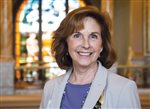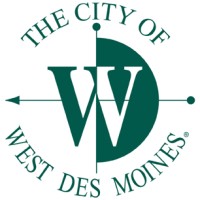A Closer Look: Barbara Stinson
President, World Food Prize Foundation

Barbara Stinson counts herself as very fortunate to follow in the footsteps of Ambassador Kenneth Quinn in leading the World Food Prize Foundation, particularly at this critical juncture for the future of the global food supply. For 23 years, she led an environmental policy group, the Meridian Center, as one of its co-founders. There, she applied a multidisciplinary approach to improving health conditions in 22 countries in Africa where a highly toxic condition known as aflatoxin was killing crops, livestock and people. The outdoors were part of her life from early on — Stinson was raised in a small ranching community on the outskirts of Austin, Texas. She moved to Boulder, Colo., when she was 17 to study environmental conservation at the University of Colorado. The Rockies are still in her blood, and she enjoys winter trips to ski with her husband and three grown children. Her academic training helped cultivate an appreciation for other cultures and a lifelong passion for travel. Her husband, Donald, is an accomplished artist with a space at MainFrame Studios in Des Moines. They reside near the Des Moines River in the East Village, within walking distance of the historic World Food Prize Hall of Laureates.
Tell me about your career path, and how it led you into your varied leadership roles.
In college I studied environmental conservation and planning from the standpoint of geography, economics and biology, so that multidisciplinary approach affected me from the very beginning — I was always looking at issues from multiple angles. And in college I had the opportunity to begin to study and understand the field of mediation and conflict resolution, which was growing so much in the ’70s and ’80s. And so I ended up deciding to pursue a career in planning, but from a collaborative standpoint.
Who was an influencer for you early on?
I had the opportunity to attend MIT; that was really the only place you could get an environmental policy and planning degree and study mediation. And there’s a gentleman there who’s a tremendous forefather of the whole field and an inspiration to many — Larry Susskind. He was my professor, and I studied and worked under him and saw early on the benefits of tackling really intractable problems from a multi-stakeholder point of view. Trying to make better decisions was much more successful in this kind of collaborative environment.
That multidisciplinary approach wasn’t very mainstream at the time, right?
No, not at all. I mean you saw mediation in divorce settlement. And that’s really where the field grew out of. But what you were seeing in the ’70s and ’80s were all of these important environmental statutes being written and decisions trying to be made, but primarily on the basis of legal challenge. And that’s an important underpinning to mediation is to have that legal standing for all the parties so that they could challenge the decisions. But our field soon grew in the 1980s especially out of the need to try to do better than the legal system could offer. I spent seven years with the Keystone Policy Center and got tremendous exposure to a whole array of public policy challenges. And I saw the effectiveness of this deliberative decision-making process contributing to much better decisions.
Tell me about the nonprofit agricultural policy group that you co-founded.
Five of us [from the Keystone Policy Center] decided to form our own nonprofit organization in 1997. We started out as five people but we grew to our largest at 50. … Having my own organization where I was a founder with partners and tackling these really intractable issues in this fashion was formative in my career. In 2010 I had the opportunity to take my agriculture experience and really try to apply it to problems going on in Africa. So in 2010, I began work on reducing the harmful effects of aflatoxin on public health and on crops. Various value chains in Africa were contaminated with aflatoxin, which is a highly toxic naturally occurring substance.
How did this opportunity with the World Food Prize come about?
In 2019, I was making a decision at the Meridian Institute to potentially retire and move on to do something else in my career and turn my organization over to the next generation, if you will. In the course of making that decision I heard that Ambassador Quinn was retiring. I noted that with interest, but I humbly was not thinking of myself at all in that position. Lo and behold, within a few weeks I had received a recommendation to be considered for the position. … I was just honored from the very beginning. I carefully examined the mission, the work and history of the organization and all that had been built by Ambassador Quinn, and I thought, what a tremendous opportunity in my career to take on the challenge of building the World Food Prize into its next generation.
How would you describe your passion for environmental policy work?
I’ve been involved in agriculture and trying to more effectively plan for different needs and issues in the world of agriculture for decades. And I had this opportunity to tackle aflatoxin and create an institution that in Africa manages a really difficult challenge. But I have to say that I’ve worked on many, many issues in the course of my career.
In 2010 I had the opportunity for the first time to travel to Uganda. It was a time of tremendous turmoil; there was tremendous poverty and huge issues in agriculture and people in the rural areas unable to feed themselves. You had a terrible situation with young girls that were being raped and mistreated and conscripted. I had the opportunity to travel to an all-girls school in western Uganda. So I visited this school of 200 girls who all had shaved heads, which is a common practice, particularly in Uganda, because then you can’t distinguish the girls from the boys. So here are kids in grade schools that have qualified to attend this residential grade school where they’re going to be more protected and they’re going to be educated in agriculture. It was a very successful model where young girls are learning how to envision a different future and they’re learning the farming practices that are needed to be able to grow more than subsistence farming food. It was a huge inspiration to me of seeing not only Norman Borlaug’s mission at work and what agriculture can do to feed the world, but also seeing how empowering women and empowering young farmers can take place.
What other travel experiences have been meaningful for you?
I haven’t been to nearly as many countries as Ambassador Quinn. But I’ve traveled to 14 countries in Africa, and I’ve traveled extensively throughout Europe and a bit in Southeast Asia as well. And in all my travels I’m always amazed to land and really try to understand completely different and new cultures. I love that I studied in Denmark when I was 20 years old and learned to speak Danish fluently. So I’ve always had an appreciation for other cultures and respect for them and trying to take the learnings of other cultures and and bring it back to the United States, as well as offer ours to other countries, which was part of the work in Africa.
Tell me about the culture of the World Food Prize Foundation and how you will carry that forward.
The World Food Prize has just a tremendous international and national reputation. It’s also really well known in the state for all the service and support of local initiatives that we have. And of course the [headquarters] building is a tremendous asset. Thousands of visitors come through the building every year with events that we host. In my tenure I want to build on that. The culture here is one of trying to be a good community steward, but also serving this global goal.
What are some ways the organization will do that?
We’ll be collaborative not only in our work together but in our work in the community and with all of our stakeholders. The first thing that we did was to develop and launch a survey to some 10,000 individuals around the world and here in Iowa, to get their point of view on what is strong about the World Food Prize, what has gone well, what are the pieces and activities and components of the programs to retain, what needs to evolve and change, and what are the gaps and areas of service that we can fill. So we’ve collected almost 500 survey responses, and we’re summarizing those and digesting them deeply, and we’re going to use those for strategic planning within the organization here in the first year. So you’ll see some innovations this year; we’ll make some changes to some of our programming.
Other thoughts about your role in leading the organization?
The mission of the World Food Prize is more relevant today than at any time, in my opinion. Global food security is top of mind for everyone, because we know we need to feed approaching 9 billion people by 2050. And it has captured the work of so many. We understand now that we have to address the entire food system in order to be able to do that, which means that not only do you have to be growing better food and more of it, but it’s also got to be more nutritious, and the distribution has to be strong, and the food has to be safe. The environmental consequences have to be addressed, and the impacts of climate change on agriculture have to be addressed if we’re going to meet this goal. So I feel like I’m taking on this challenge at a really tremendous time in history to try to contribute more to solving that problem.
What are some of your hobbies? Do you share your husband’s love for art?
When we met I knew very little about art, and now I know a substantial amount. My husband’s a tremendous historian of art. He is a walking encyclopedia and understands every genre and the history of all of them and his art connects to all of it, or whatever it connects to he knows very well. So I do have a tremendous appreciation of art, and we have beautiful art here in the building and it’s one of the things I love. My husband and I met skiing in Utah, not Colorado, and we have three adult kids who are all expert skiers, and so that’s probably our No. 1 passion — we love to ski. We also bike. I don’t know if I can do RAGBRAI, but we are going to bike. We’ll be out there. The trails here are wonderful and that was a big attraction. I am a Pisces so I love all watersports, so I’m sure I will be kayaking, canoeing, etc. And I practice yoga and I studied taekwondo for many years. And I was a big runner for many years.








